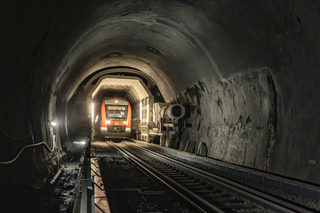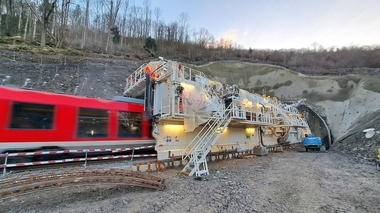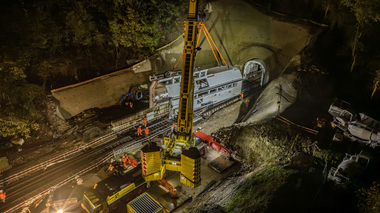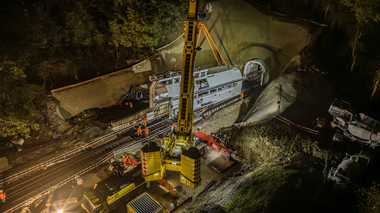Turning Old Into New: Tunnel Enlargement During Operation
In the second half of the 19th and early 20th century, hundreds of railway tunnels were built in Europe. They are largely still in operation today. In the coming decades, a considerable number of tunnels are due for substantial renewal. With the Tunnel Enlargement System (TES), Herrenknecht has developed a solution for enlarging the tunnel profile of old railway tunnels while rail traffic continues to run.
Enlargement of the Fachingen and Cramberg Tunnel Profiles
Two Tunnel Enlargement Systems have been in use since January 2024 for the renewal of Deutsche Bahn tunnels near Limburg an der Lahn. The 160-year-old tunnels will thus be renovated while rail service continues. The 426 m long Fachingen Tunnel and the 732 m long Cramberg Tunnel are part of the Lahn Valley Railway connecting the cities of Koblenz and Wetzlar.
 Train passing through the Tunnel Enlargement System on the Lahn Valley Railway, shortly before the start of excavation work on the Cramberg Tunnel
Train passing through the Tunnel Enlargement System on the Lahn Valley Railway, shortly before the start of excavation work on the Cramberg Tunnel
Credit/Quelle: Axel Langer/Herrenknecht
With the start of industrialization in the 19th century, the construction of railway lines and the associated tunnels began. In Austria, Switzerland and Germany alone, around 800 tunnels were built between 1850 and 1910. They are now getting on in years. In order to electrify the lines, accommodate larger track gauges and faster trains, comply with current safety standards or replace the tunnel lining due to age, it is necessary to enlarge the tunnel profile.
The Tunnel Enlargement System developed by Herrenknecht makes it possible to carry out tunnel renewal during ongoing rail operation. First the existing tracks are dismantled, and a track is laid in the middle of the existing tube instead. Rail traffic will continue to run safely on this track throughout the entire construction period. The TES moves forward step by step during excavation for the widening of the tunnel. At the same time, it serves as a protective enclosure and separates the construction work from ongoing rail traffic.
Radius of the Cross Sections Enlarged by 2 Meters
For the two double-track tunnels of the Lahn Valley Railway, the radius of the tunnel cross sections will be enlarged by a good 2 m, thus achieving dimensions corresponding to state-of-the-art new tunnels. The approximately 46 m long, 270 t TESs with a diameter of around 12 m for the Fachingen and Cramberg tunnels run on foundations and rails specially laid in the tunnel.
 Inside the Cramberg Tunnel: Tunnel Enlargement System during ongoing rail operations
Inside the Cramberg Tunnel: Tunnel Enlargement System during ongoing rail operations
Credit/Quelle: Axel Langer/Herrenknecht
The TESs are equipped for conventional excavation and support work. Depending on the hardness of the rock, excavation is done by chiseling or blasting. First, the old tunnel walls, usually masonry, are broken out. This is followed by excavation of the rock by chiseling or blasting and removal of the material. The excavated material falls to the side of the machine into the tunnel invert and is removed by separate conveyor and loading equipment.
After each drilling and blasting round, a sprayed concrete manipulator applies the temporary sprayed concrete support. The rock is also stabilized with anchors. Reinforcement mesh and steel arches together with the sprayed concrete and anchors form the initial support. Once tunnelling with the TES has been completed, the final lining of the tunnel using in-situ concrete is then carried out in a second construction phase.
TES Divided Into Three Machine Sections
 Cramberg Tunnel: Excavation of the rock with the hydraulic impact hammer of the Tunnel Enlargement System
Cramberg Tunnel: Excavation of the rock with the hydraulic impact hammer of the Tunnel Enlargement System
Credit/Quelle: Axel Langer/Herrenknecht
The TES consists of three parts. The front part of the machine is used for pre-excavation protection. It prevents the existing tunnel from collapsing in the area ahead of the respective excavation work or rock falling onto the tracks. The middle section is the carrier for the equipment required for tunnelling: telescopic drill rigs on both sides, hydraulic impact hammer on a central boom with a large radius of action, sprayed concrete system on a ring guide. The machine has large, retractable working platforms, that allow the workers to safely reach the tunnel face and the intrados. The equipment for operating the TES is located in the rear part of the machine. This includes a hydraulic station to supply the hydraulically driven equipment, a compressor for the supply of compressed air, the electrical system, and material storage.
The design of the TES used on the Lahn Valley Railway incorporated the consortium's experience from previous projects and that of Herrenknecht from the use of a first TES in Spain. Renovation of the 558 m long Gaintxurizketa Tunnel between Astigarraga and Irun in the foothills of the Basque Pyrenees was completed in March 2024. The renovated tunnel will improve the connection between the Spanish and French rail networks as part of the EU's future Atlantic corridor.





